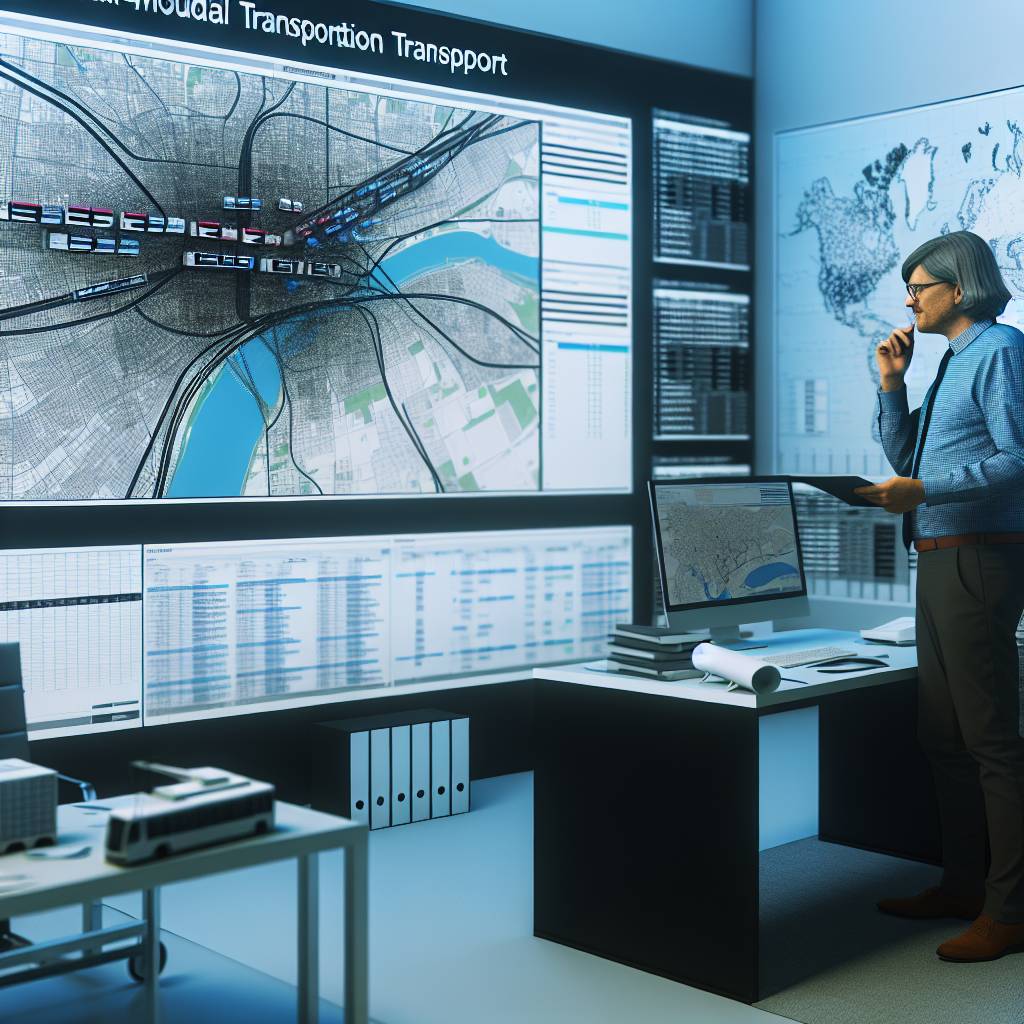Introduction:
Transportation planning involves designing, managing, and evaluating transportation systems to meet current and future demand.
It plays a crucial role in shaping communities and improving quality of life.
Staying informed about future trends in transportation planning is vital for ensuring that transportation systems are efficient, sustainable, and equitable.
By understanding upcoming changes and innovations, planners can anticipate challenges and opportunities to better serve the needs of users.
Increased focus on sustainable transportation:
Growing emphasis on reducing carbon emissions and promoting environmentally-friendly modes of transportation.
Development of infrastructure to support walking, cycling, and public transport.
As we look towards the future of transportation planning, one of the key trends that will continue to gain prominence is the focus on sustainable transportation.
This shift is driven by the recognition of the negative impacts of traditional modes of transportation on the environment and public health.
Governments, urban planners, and transportation authorities are increasingly prioritizing the development of infrastructure that supports walking, cycling, and public transport as viable alternatives to single-occupancy vehicles.
This not only helps reduce carbon emissions but also promotes a healthier lifestyle for residents.
One of the ways in which this trend is manifesting is through the integration of sustainable transportation options into urban planning strategies.
Cities are now designing transportation systems that prioritize pedestrian-friendly infrastructure, dedicated cycling lanes, and efficient public transport networks.
This holistic approach aims to create a multimodal transport system that not only reduces the reliance on cars but also enhances connectivity within urban areas.
Furthermore, there is a growing recognition of the need to invest in alternative modes of transportation that prioritize sustainability.
This includes initiatives such as electric buses, bike-sharing programs, and carpooling services, which offer environmentally-friendly alternatives to traditional modes of transport.
By encouraging the adoption of these options, cities can reduce their carbon footprint and improve air quality for residents.
In addition, the development of smart transportation systems is playing a crucial role in promoting sustainable transportation.
By leveraging technology and data analytics, cities can optimize traffic flow, reduce congestion, and encourage the use of public transport.
This not only makes transportation more efficient but also enhances the overall quality of life for residents by reducing travel times and improving air quality.
Overall, the increased focus on sustainable transportation in transportation planning reflects a broader shift towards creating cities that are inclusive, environmentally-conscious, and resilient.
Transform Your Career Today
Unlock a personalized career strategy that drives real results. Get tailored advice and a roadmap designed just for you.
Start NowBy investing in infrastructure that supports walking, cycling, and public transport, cities can reduce their carbon footprint, improve air quality, and create a more livable urban environment for residents now and in the future.
Integration of technology:
Incorporation of smart technologies to improve traffic management and enhance user experience.
Utilization of data analytics and predictive modeling for efficient transportation planning.
Smart Technologies in Transportation Planning
Integrating smart technologies into transportation planning is key to addressing the challenges of urban mobility.
By incorporating technologies such as GPS tracking, sensors, and real-time data analysis, cities can optimize traffic management and improve the overall user experience.
One of the primary benefits of smart technologies is the ability to collect and analyze data in real-time.
This data can then be used to monitor traffic flow, identify congested areas, and even predict future traffic patterns.
By leveraging this information, transportation planners can make informed decisions to alleviate traffic congestion and improve overall transportation efficiency.
Data Analytics and Predictive Modeling
Data analytics and predictive modeling have revolutionized transportation planning by enabling planners to forecast future trends and make proactive decisions.
By analyzing historical data and trends, transportation planners can identify potential challenges and develop strategies to address them before they escalate.
Predictive modeling allows planners to simulate various scenarios and evaluate their impact on traffic flow and transportation infrastructure.
By incorporating predictive models into the planning process, cities can anticipate future challenges and develop strategies to mitigate them effectively.
The integration of technology, such as smart technologies, data analytics, and predictive modeling, is essential for efficient transportation planning.
By incorporating these technologies into the planning process, cities can optimize traffic management, enhance user experience, and create a more sustainable transportation system for the future.
Discover More: Balancing Efficiency and Cost in Distribution Management
Emphasis on multi-modal transportation:
– Shift towards a more integrated transportation system that includes various modes of transport such as cars, buses, trains, and bikes.
– Implementation of policies to encourage interconnectivity and seamless transfers between modes.
In the realm of transportation planning, there has been a notable emphasis on promoting multi-modal transportation options.
To address the growing concerns over traffic congestion, air pollution, and inefficient transport systems, cities are increasingly looking towards a more holistic approach that incorporates different modes of transportation.
Showcase Your Business Today
Reach thousands of readers actively exploring professional services. Publish your business profile and grow your audience now.
Publish NowOne of the key aspects of this trend is the shift towards a more integrated transportation system.
Rather than focusing solely on individual modes of transport, there is a growing recognition of the benefits of having a network that seamlessly connects cars, buses, trains, and bikes.
This approach not only offers more flexibility and convenience to commuters but also helps in reducing the overall environmental impact of transportation.
To support this shift towards multi-modal transportation, many cities and regions are implementing policies that encourage interconnectivity between different modes of transport.
This includes initiatives such as building dedicated bike lanes, improving pedestrian walkways, and creating integrated transport hubs that allow for seamless transfers between modes.
By making it easier for people to switch between different modes of transport, these policies not only reduce congestion on roads but also promote healthier and more sustainable ways of commuting.
Furthermore, advancements in technology have played a significant role in enabling multi-modal transportation.
The rise of ride-sharing services, bike-sharing programs, and real-time transit apps has made it easier for people to plan and navigate their journeys using a combination of different modes of transport.
This has not only enhanced the overall commuting experience but has also helped in reducing reliance on single-occupancy vehicles, thus alleviating traffic congestion and improving air quality.
The emphasis on multi-modal transportation in transportation planning is a positive trend that not only promotes efficiency and sustainability but also enhances the overall quality of life for residents.
By integrating various modes of transport and implementing policies that encourage seamless transfers between them, cities are taking a step towards creating a more connected and sustainable transport system for the future.
You Might Also Like: How to Become a Successful Courier in the USA
Rise of Shared Mobility Services
Increasing popularity of ride-sharing, car-sharing, and bike-sharing services.
This trend has been driven by various factors including advancements in technology, changing consumer preferences, and increasing concerns about environmental sustainability.
As a result, these services have had a profound impact on urban mobility patterns.
This necessitates the need for regulations to address challenges and ensure fair competition among service providers.
One of the key benefits of shared mobility services is the potential to reduce traffic congestion.
These services improve overall transportation efficiency in urban areas.
By providing alternatives to individual car ownership, they help optimize the use of existing transportation infrastructure.
This can lead to reduced emissions and improved air quality.
Consequently, it makes cities more livable and sustainable in the long run.
Furthermore, the rise of shared mobility services has sparked a debate about the future of transportation planning.
This debate questions the role of government in regulating these services.
While proponents argue that shared mobility offers a more cost-effective and environmentally friendly alternative to traditional transportation options, critics raise concerns about safety, security, and fair competition.
As a result, there is a growing need for policymakers to develop regulations that strike a balance.
These regulations should promote innovation while protecting the interests of consumers and other stakeholders.
For example, regulators may need to establish guidelines for driver training and background checks.
Such standards ensure the safety of passengers using ride-sharing services.
Similarly, rules governing the pricing and availability of shared mobility services may be necessary.
They can prevent monopolistic behavior and ensure fair competition among service providers.
Moreover, regulations could address issues such as data privacy and insurance requirements.
They should also encompass accessibility for individuals with disabilities.
This ensures that shared mobility services are inclusive and equitable for all members of society.
The rise of shared mobility services represents a transformative shift in transportation planning and urban mobility.
By leveraging technology and collaborative consumption, these services revolutionize our approach to transportation.
They can create more sustainable, efficient, and equitable cities.
To realize these benefits, policymakers must address the challenges associated with shared mobility.
This requires comprehensive and forward-thinking regulations.
You Might Also Like: Dealing with Difficult Passengers: Strategies for Bus Drivers
Adoption of Autonomous Vehicles:
Autonomous vehicles are a significant aspect of future transportation planning.
Showcase Your Business Today
Reach thousands of readers actively exploring professional services. Publish your business profile and grow your audience now.
Publish NowThe progress in the development of self-driving cars and trucks is rapidly advancing.
This progress is bringing about a revolution in the way people and goods are transported.
Progress in Development of Self-Driving Cars and Trucks
- Major automotive companies are investing heavily in autonomous vehicle technology.
- Technological advancements in sensors, cameras, and artificial intelligence are key drivers of progress.
- Testing of self-driving cars on public roads is becoming more widespread.
Potential Benefits of Autonomous Vehicles
- Improved safety: Autonomous vehicles have the potential to significantly reduce accidents caused by human error.
- Reduced traffic congestion: Self-driving cars can communicate with each other to optimize traffic flow.
- Enhanced mobility for elderly and disabled individuals: Autonomous vehicles can provide a new level of independence for those who may have difficulty driving.
The adoption of autonomous vehicles is set to revolutionize transportation planning.
The benefits of improved safety, reduced traffic congestion, and enhanced mobility for vulnerable populations make self-driving cars and trucks a key component of the future of transportation.
Gain More Insights: Trends Shaping the Future of Supply Chain Analysis

Resilience and Adaptation to Climate Change
Climate change is a pressing issue that cannot be ignored when it comes to transportation planning.
The transportation sector is a significant contributor to greenhouse gas emissions, which exacerbate climate change.
As a result, transportation planners must consider the impacts of climate change on infrastructure and future planning.
Consideration of Climate Change Impacts on Transportation Infrastructure
- Understanding how climate change will affect transportation infrastructure is essential for effective planning.
- Rising sea levels, increased temperatures, and extreme weather events can all impact roads, bridges, and other critical transportation assets.
- For example, coastal roads may be at risk of flooding due to sea-level rise, while extreme heat can cause pavement to deteriorate more rapidly.
Implementation of Measures to Enhance Resilience
- Transportation planners must take proactive steps to enhance the resilience of infrastructure to climate change impacts.
- This can involve integrating climate change considerations into design standards and maintenance practices.
- For instance, using more durable materials or designing infrastructure to withstand higher temperatures can help reduce vulnerability.
Reducing Vulnerability to Extreme Weather Events
- Extreme weather events, such as hurricanes, floods, and wildfires, are becoming more frequent and severe due to climate change.
- Transportation planners need to develop strategies to reduce vulnerability to these events.
- This could include improving drainage systems, implementing flood protection measures, and reinforcing critical infrastructure.
Resilience and adaptation to climate change are critical components of future transportation planning.
By considering the impacts of climate change on infrastructure and implementing measures to enhance resilience, transportation planners can ensure that the transportation system remains functional and reliable in the face of a changing climate.
Economic Considerations in Transportation Planning
When it comes to transportation planning, economic factors play a crucial role in determining the feasibility and success of various projects.
Here are some key considerations:
Evaluation of Cost-Effectiveness and Benefits
- Before embarking on any transportation project, planners must evaluate the cost-effectiveness of the proposed solution.
- This involves conducting thorough cost-benefit analyses to determine whether the benefits outweigh the costs.
- Factors such as construction costs, maintenance expenses, and projected usage must be taken into account.
- By assessing the economic viability of a project, planners can make informed decisions about which initiatives to prioritize.
Need for Sustainable Funding Sources
- One of the biggest challenges in transportation planning is securing sustainable funding sources to support long-term goals.
- Many projects require significant investment not only in the initial stages but also for ongoing maintenance and upgrades.
- Governments and organizations must explore various funding options, including public-private partnerships and grants.
- By diversifying funding sources, planners can ensure that projects have the financial support needed to succeed.
Economic considerations are fundamental to the success of transportation planning efforts.
By carefully evaluating cost-effectiveness and securing sustainable funding sources, planners can ensure that projects are not only feasible but also beneficial to society in the long run.
Key Future Trends in Transportation Planning
Recap of key future trends in transportation planning discussed in the blog post: The blog post highlighted the shift towards sustainable and efficient mobility solutions.
Current trends include electric vehicles, autonomous vehicles, shared mobility services, and active transportation options.
Importance of anticipating and adapting to changes in transportation planning to ensure sustainable and efficient mobility systems: It is crucial for urban planners and policymakers to stay ahead of emerging trends in transportation.
This approach is essential to meet the evolving needs of communities, reduce traffic congestion, lower emissions, and improve overall quality of life.
By integrating innovative technologies and solutions into transportation planning, cities can create more accessible, equitable, and environmentally-friendly transportation systems for the future.
Additional Resources
Online Bachelor’s Logistics Management Degree | American Military …




